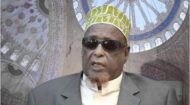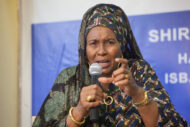The Somali-American youths who have disappeared from their Twin Cities homes “are part of a disquieting trend that has emerged in recent years” in the form of homegrown terrorism, said the report by the Washington-based Bipartisan Policy Center’s National Security Preparedness Group.
The report found that federal officials failed to realize that Somali-American youths traveling from Minnesota to Mogadishu in 2008 to join extremists were not isolated individuals. Instead, the movement was one among several instances of a broader, more diverse threat that has surfaced across the country.
The report concludes: “Our long-held belief that homegrown terrorism couldn’t happen here has thus created a situation where we are today stumbling blindly through the legal, operational and organizational minefield of countering terrorist radicalization and recruitment occurring in the United States.”
But B. Todd Jones, U.S. attorney for the District of Minnesota, disputes the notion that officials here “were asleep at the wheel.” The Minneapolis FBI, he said, began investigating the recruitment and radicalization of local Somali youths months before a Minneapolis man blew himself up in Somalia in late 2008, he said.
“They have their finger on the pulse of a lot of stuff,” Jones said, praising the FBI for its efforts at counterterrorism and intelligence gathering.
Helping Al-Shabab
Last month, federal officials announced the indictments of 14 people — including 12 Minnesotans — for allegedly providing support to Al-Shabab, a Somali group that the State Department has classified as a terrorist organization. For more than two years, Minneapolis has been at the center of a sweeping investigation into the recruitment of 20 or so young men to train and fight with Al-Shabab.
Local FBI officials have acknowledged that those who left Minneapolis have raised fears that some could return to commit violence here, although they say they have no indication of such intent.
“That is a threat we cannot overlook,” said Special Agent E.K. Wilson of the Minneapolis FBI office. “We don’t have specific information that this is an objective of Al-Shabab. But, just to be thorough, we can’t overlook that possibility.”
Several of those who left Minnesota have since been killed. Some have returned and have been jailed, charged and convicted. Others remain overseas.
Stephen L. Smith is a local attorney who has represented young Somalis who have testified before a grand jury investigating the recruitment of young people here. Many of the young men he has dealt with went to Somalia to fight against Ethiopian troops that once occupied the country, he said. Later, others went to fight for Al-Shabab against the provisional government and help establish an Islamic state in their war-torn and chaotic homeland.
“It appears that the intent was not to engage in terrorist activity in general,” Smith said. “Many of them do not see themselves as terrorists, in the way we understand the word.”
No federal agency is specifically charged with identifying radicalization or working to prevent terrorist recruitment of U.S. citizens and residents, the report said.
The authors, headed by former 9/11 Commission leaders Tom Kean and Lee Hamilton, laid out a detailed description of domestic terror incidents ranging from the Fort Hood, Texas, shooting spree and the attempted Christmas Day airliner attack in late 2009 to last May’s botched truck bombing in New York’s Times Square.
Officials have believed that the nation’s melting pot of nationalities and religions would protect it from internal radical strife, the report said.
‘Fundamentally troubling’
The terrorists, said the report, may have discovered America’s “Achilles heel in that we currently have no strategy to counter the type of threat posed by homegrown terrorists and other radicalized recruits.”
“It is fundamentally troubling, given this collection of new threats and new adversaries directly targeting America, that there remains no federal government agency or department specifically charged with identifying radicalization and interdicting the recruitment of U.S. citizens or residents for terrorism. … America is thus vulnerable to a threat that is not only diversifying, but arguably intensifying.”
Federal officials have acknowledged the need to address the radicalization problem, and for the first time, the White House this year added combating homegrown terrorism to its national security strategy.
According to the report, “as the ranks of U.S. recruits have grown, the new front lines have become the streets of Bridgeport, Denver, Minneapolis and other big and small communities across America.”
Understanding is key
But Jones said the challenge for federal agencies will be to address radicalization while also respecting constitutional and civil rights. “The real threat is that the fix is going to be worse than the problem here,” the U.S. attorney said. “They win if we overreact.”
He added that the U.S. Justice Department has made it a priority to increase understanding and communication among federal officials and Muslim communities.
Wilson said FBI officials in Minneapolis continue to reach out to community, youth and religious leaders to increase understanding with the local Somali community.
Still, communication and understanding may not be enough, said Abdirizak Bihi, head of the Somali Education and Social Advocacy Center in Minneapolis. The seeds of radicalization may be sown in the hopelessness felt by Somali youth here.
An uncle of a Minneapolis man killed in Somalia, Bihi has been working to give local Somalis alternatives to the seduction of Al-Shabab. But winning the hearts and minds of young Somalis has been stymied by a lack of resources and a seeming indifference on the part of local public officials, he said.
For the past few days, he’s been trying scrounge up enough cash to keep a gym open for basketball.
“It all comes down to resources. There are no resources for Somali-American youth,” he said. “Eighty percent of them who are employable are unemployed. They are isolated from their own community and from the larger community.
“There is no easy answer.”
The Associated Press contributed to this report.

 All Posts
All Posts









